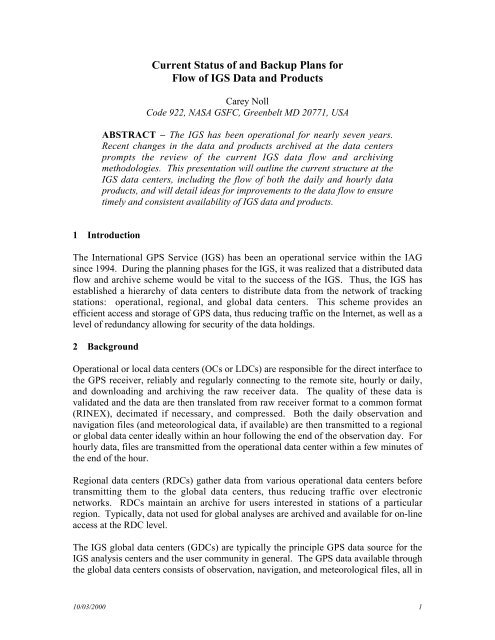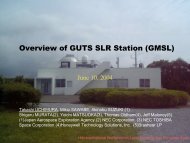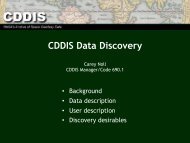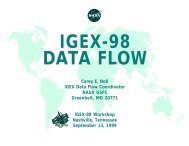Current Status of and Backup Plans for Flow of IGS Data and Products
Current Status of and Backup Plans for Flow of IGS Data and Products
Current Status of and Backup Plans for Flow of IGS Data and Products
Create successful ePaper yourself
Turn your PDF publications into a flip-book with our unique Google optimized e-Paper software.
<strong>Current</strong> <strong>Status</strong> <strong>of</strong> <strong>and</strong> <strong>Backup</strong> <strong>Plans</strong> <strong>for</strong><br />
<strong>Flow</strong> <strong>of</strong> <strong>IGS</strong> <strong>Data</strong> <strong>and</strong> <strong>Products</strong><br />
Carey Noll<br />
Code 922, NASA GSFC, Greenbelt MD 20771, USA<br />
ABSTRACT – The <strong>IGS</strong> has been operational <strong>for</strong> nearly seven years.<br />
Recent changes in the data <strong>and</strong> products archived at the data centers<br />
prompts the review <strong>of</strong> the current <strong>IGS</strong> data flow <strong>and</strong> archiving<br />
methodologies. This presentation will outline the current structure at the<br />
<strong>IGS</strong> data centers, including the flow <strong>of</strong> both the daily <strong>and</strong> hourly data<br />
products, <strong>and</strong> will detail ideas <strong>for</strong> improvements to the data flow to ensure<br />
timely <strong>and</strong> consistent availability <strong>of</strong> <strong>IGS</strong> data <strong>and</strong> products.<br />
1 Introduction<br />
The International GPS Service (<strong>IGS</strong>) has been an operational service within the IAG<br />
since 1994. During the planning phases <strong>for</strong> the <strong>IGS</strong>, it was realized that a distributed data<br />
flow <strong>and</strong> archive scheme would be vital to the success <strong>of</strong> the <strong>IGS</strong>. Thus, the <strong>IGS</strong> has<br />
established a hierarchy <strong>of</strong> data centers to distribute data from the network <strong>of</strong> tracking<br />
stations: operational, regional, <strong>and</strong> global data centers. This scheme provides an<br />
efficient access <strong>and</strong> storage <strong>of</strong> GPS data, thus reducing traffic on the Internet, as well as a<br />
level <strong>of</strong> redundancy allowing <strong>for</strong> security <strong>of</strong> the data holdings.<br />
2 Background<br />
Operational or local data centers (OCs or LDCs) are responsible <strong>for</strong> the direct interface to<br />
the GPS receiver, reliably <strong>and</strong> regularly connecting to the remote site, hourly or daily,<br />
<strong>and</strong> downloading <strong>and</strong> archiving the raw receiver data. The quality <strong>of</strong> these data is<br />
validated <strong>and</strong> the data are then translated from raw receiver <strong>for</strong>mat to a common <strong>for</strong>mat<br />
(RINEX), decimated if necessary, <strong>and</strong> compressed. Both the daily observation <strong>and</strong><br />
navigation files (<strong>and</strong> meteorological data, if available) are then transmitted to a regional<br />
or global data center ideally within an hour following the end <strong>of</strong> the observation day. For<br />
hourly data, files are transmitted from the operational data center within a few minutes <strong>of</strong><br />
the end <strong>of</strong> the hour.<br />
Regional data centers (RDCs) gather data from various operational data centers be<strong>for</strong>e<br />
transmitting them to the global data centers, thus reducing traffic over electronic<br />
networks. RDCs maintain an archive <strong>for</strong> users interested in stations <strong>of</strong> a particular<br />
region. Typically, data not used <strong>for</strong> global analyses are archived <strong>and</strong> available <strong>for</strong> on-line<br />
access at the RDC level.<br />
The <strong>IGS</strong> global data centers (GDCs) are typically the principle GPS data source <strong>for</strong> the<br />
<strong>IGS</strong> analysis centers <strong>and</strong> the user community in general. The GPS data available through<br />
the global data centers consists <strong>of</strong> observation, navigation, <strong>and</strong> meteorological files, all in<br />
10/03/2000 1
RINEX <strong>for</strong>mat. The GDCs provide an on-line archive <strong>of</strong> daily <strong>and</strong> sometimes hourly<br />
data files as well as the products derived from these data, generated by the <strong>IGS</strong> analysis<br />
centers, associate analysis centers, <strong>and</strong> analysis coordinators. These data centers equalize<br />
holdings <strong>of</strong> global sites <strong>and</strong> derived products on a daily basis (at minimum). The three<br />
GDCs currently supporting the service provide the <strong>IGS</strong> with a level <strong>of</strong> redundancy, thus<br />
preventing a single point <strong>of</strong> failure should a data center become unavailable.<br />
Furthermore, three centers reduce the network traffic that could occur to a single<br />
geographical location.<br />
3 <strong>Current</strong> flow <strong>of</strong> data <strong>and</strong> system status<br />
Table 1 lists the major data centers currently supporting the <strong>IGS</strong>. Table 2 lists the types<br />
<strong>of</strong> data archived by the <strong>IGS</strong> data centers <strong>and</strong> the products created by the <strong>IGS</strong> analysis<br />
centers; Table 3 shows the types <strong>of</strong> data <strong>and</strong> products supported at the global data center<br />
archives.<br />
Figure 1 depicts the current flow <strong>of</strong> thirty-second daily data files from the OCs to the<br />
GDCs. Only sites with complete site logs at the <strong>IGS</strong> Central Bureau are reflected in this<br />
figure. Both the CDDIS <strong>and</strong> SIO archive data from sites outside the <strong>IGS</strong> “umbrella”;<br />
these sites are not listed in the figure or table. Figure 2 shows the data flow <strong>for</strong> hourly<br />
data files; at this time, hourly data are archived <strong>and</strong> distributed by the GDCs at CDDIS<br />
<strong>and</strong> IGN <strong>and</strong> the RDC at BKG.<br />
To aid in further underst<strong>and</strong>ing the flow <strong>of</strong> daily <strong>and</strong> hourly data files within the <strong>IGS</strong>, it is<br />
important to study the timeliness <strong>of</strong> the data products. Table 4 presents the data latency<br />
statistics <strong>for</strong> daily data archived at the CDDIS. Over fifty percent <strong>of</strong> the data are archived<br />
within two hours <strong>of</strong> the end <strong>of</strong> the observation day. Table 5 presents the current data<br />
latency statistics <strong>for</strong> hourly data at the CDDIS. As can be seen from this table, over fifty<br />
percent <strong>of</strong> the hourly data are available <strong>for</strong> download from the CDDIS within fifteen<br />
minutes. These statistics were derived by programs developed by the <strong>IGS</strong> Central Bureau<br />
<strong>and</strong> executed on a regular basis at many <strong>of</strong> the <strong>IGS</strong> data centers; the results <strong>for</strong> the<br />
CDDIS are updated frequently during the day <strong>and</strong> can be viewed at<br />
ftp://cddisa.gsfc.nasa.gov/pub/reports/gpsdata/check_import.cddisa (daily data) <strong>and</strong><br />
ftp://cddisa.gsfc.nasa.gov/pub/reports/gpsdata/check_hourly.cddisa (hourly data).<br />
4 <strong>Backup</strong> strategies<br />
The mission <strong>of</strong> the <strong>IGS</strong> has been broadened to include the flow <strong>and</strong> analysis <strong>of</strong> hourly<br />
data sets, thus requiring a rapid turn-around <strong>of</strong> data from the station to the user.<br />
Furthermore, this access must be reliable, 24 hours per day, seven days per week. The<br />
<strong>IGS</strong> infrastructure must establish backup data flow paths to ensure that not only daily but<br />
also hourly data sets are accessible to users on an uninterrupted basis even if a key data<br />
center is unavailable. This scheme must be extended to include hourly high-rate data sets<br />
at those data centers supporting the ef<strong>for</strong>ts <strong>of</strong> future LEO missions.<br />
10/03/2000 2
During the past year, the CDDIS global data center experienced two major computer<br />
failures. Un<strong>for</strong>tunately, the extended outage <strong>of</strong> the facility had dramatic effects on the<br />
<strong>IGS</strong> analysis centers <strong>and</strong> the user community in general since some sites only deposited<br />
their data at CDDIS. Furthermore, most <strong>IGS</strong> ACs <strong>and</strong> AACs send their data products to<br />
the CDDIS where they are made available to the other <strong>IGS</strong> data centers, the <strong>IGS</strong> ACs <strong>and</strong><br />
AACs, <strong>and</strong> the user community. Not only were some data <strong>and</strong> products not immediately<br />
available, the CDDIS user community may have been unfamiliar with accessing the other<br />
data centers. Some redundant data flow paths already existed, but other sites had no data<br />
center to transmit their data to when the CDDIS was down. To prevent the unavailability<br />
<strong>of</strong> key <strong>IGS</strong> sites in the future, a strategy <strong>for</strong> the backup <strong>of</strong> the <strong>IGS</strong> data flow infrastructure<br />
must be developed <strong>and</strong> tested. This plan, once operational, can then be utilized in the<br />
case <strong>of</strong> planned system downtimes (e.g., <strong>for</strong> scheduled computer upgrades or network<br />
outages) or when unexpected failures occur.<br />
The first step in the development <strong>of</strong> a backup plan <strong>for</strong> data (<strong>and</strong> product) flow is to<br />
identify the current network topology; this data flow is shown in Figure 1. This figure<br />
illustrates the fact that many operational <strong>and</strong> regional data centers deposit data to the<br />
CDDIS; <strong>for</strong>tunately, SIO also has access to many <strong>of</strong> these data centers <strong>and</strong> routinely<br />
downloads data from them as well <strong>for</strong> their archive. IGN mainly h<strong>and</strong>les the flow <strong>of</strong> data<br />
in Europe with BKG <strong>and</strong> retrieves the remaining <strong>IGS</strong> global sites from either CDDIS or<br />
SIO.<br />
The second step in the development <strong>of</strong> a backup plan is to identify possible alternate data<br />
flow paths should any <strong>of</strong> the three GDCs be inaccessible; the plan can then be extended<br />
to include other major <strong>IGS</strong> data centers (e.g., RDCs). It should be noted at this time that<br />
UNAVCO serves as a backup OC <strong>for</strong> JPL. During the past few months several<br />
successful tests have been conducted between UNAVCO, JPL, <strong>and</strong> the CDDIS where<br />
UNAVCO downloads data from selected JPL stations <strong>and</strong> <strong>for</strong>wards these data to the<br />
CDDIS. The CDDIS has installed procedures to peruse the UNAVCO data delivery area<br />
<strong>and</strong> archive any data not previously found in the JPL data delivery area. This process is<br />
now in place <strong>for</strong> both daily <strong>and</strong> hourly data. Each OC is designated a secondary data<br />
flow path to another data center. The proposed alternate data routes <strong>for</strong> the distribution<br />
<strong>of</strong> daily data files through the GDCs are illustrated in Figure 3; this process could be<br />
extended to the hourly data flow. For products, the current <strong>and</strong> proposed alternate data<br />
flow paths are shown in Figure 4.<br />
In order to make the transition to another data center easier <strong>for</strong> OCs <strong>and</strong> RDCs,<br />
arrangements need to be made with each data center to minimize special instructions <strong>for</strong><br />
depositing or retrieving data. The majority <strong>of</strong> the data h<strong>and</strong>led by the CDDIS are<br />
delivered to password-protected accounts established on the computer facility <strong>for</strong> each<br />
data source. The CDDIS also retrieves data from a few data centers (e.g., AUSLIG,<br />
BKG, RDAAC, <strong>and</strong> SIO). SIO <strong>and</strong> IGN primarily retrieve data from all GPS data<br />
sources.<br />
To ensure that data can be delivered <strong>and</strong> processed quickly in a backup situation, it is<br />
recommended that each GDC (<strong>and</strong> participating RDC) establish a general ftp area that<br />
10/03/2000 3
OCs <strong>and</strong> RDCs can utilize when they are required to post data to alternate data centers<br />
because their “prime” data center is inaccessible. For example, the directory<br />
/ftp/incoming/igsdaily has been created at the CDDIS (host cddisa.gsfc.nasa.gov) to allow<br />
data centers to deposit daily GPS data via anonymous ftp. Similarly, procedures need to<br />
be established <strong>for</strong> <strong>IGS</strong> analysis centers to deposit weekly product files to alternate GDCs<br />
when their primary contact is unavailable. Automated programs could then be created at<br />
the data centers to peruse these anonymous ftp put-areas on a routine basis <strong>and</strong> process<br />
any data or products found there. These ftp areas should be secured so that files placed<br />
there can not be deleted or modified by anyone other than authorized data center<br />
personnel. A more secure method may be to allow anonymous ftp deposits through a<br />
“trusted” mode where only users from a list <strong>of</strong> pre-approved hosts could deposit files to<br />
the data center’s incoming area. Setting the protections on directories <strong>and</strong> subdirectories<br />
to prevent browsing <strong>and</strong> downloading could further enhance security with these<br />
anonymous ftp put areas by anonymous ftp users. The use <strong>of</strong> anonymous ftp to deposit<br />
data precludes the need <strong>for</strong> the data centers to establish <strong>and</strong> administer accounts <strong>for</strong> each<br />
data source <strong>and</strong> allows <strong>for</strong> easy monitoring <strong>for</strong> incoming data or product files;<br />
alternatively, a single username <strong>for</strong> depositing data could be utilized at all data centers.<br />
This method, however, would require the coordination <strong>and</strong> distribution <strong>of</strong> username <strong>and</strong><br />
password in<strong>for</strong>mation to a list <strong>of</strong> data center representatives but may be more secure than<br />
anonymous ftp.<br />
These backup procedures should not only include data center instructions but user<br />
notification instructions. Furthermore, the <strong>IGS</strong> needs to determine how long the analysis<br />
community can tolerate a data center’s outage <strong>and</strong> subsequent delay in the availability <strong>of</strong><br />
either daily or hourly data products. For example, when a data center outage occurs <strong>for</strong><br />
more than one day (<strong>for</strong> centers involved in distribution <strong>of</strong> daily data only) or more than<br />
two hours (<strong>for</strong> centers involved in distribution <strong>of</strong> hourly data), the affected data center<br />
should send an advisory email to all data center contacts. If computer problems at the<br />
affected data center preclude a direct email, the data center contact should make<br />
arrangements with an alternate data center to post these alerts. This advisory message<br />
should include a description <strong>of</strong> the problem <strong>and</strong> an estimated time to recovery. At this<br />
time, the backup data flow procedures should begin. The data centers tasked to act in a<br />
backup capacity should notify the affected data center they are ready to proceed with<br />
alternate data flow procedures. Once all participants are notified <strong>and</strong> prepared, data<br />
should be transmitted to these alternate data centers. The data center or an alternate,<br />
advising the general user community <strong>of</strong> the outage <strong>and</strong> other sources <strong>for</strong> <strong>IGS</strong> data <strong>and</strong><br />
products should send an email to <strong>IGS</strong>Mail. Should the outage continue <strong>for</strong> several days,<br />
messages should be issued periodically to let the <strong>IGS</strong> community know the affected<br />
system’s current status <strong>and</strong> when users can expect operations may return to normal.<br />
Once the data center has resumed operation a follow-up email to data center contacts <strong>and</strong><br />
<strong>IGS</strong>Mail should be issued stating that “normal” operations can resume.<br />
A future enhancement to this backup data flow plan would be to automate the switchover<br />
to alternate paths. This automation could be achieved when a specified data center is<br />
unreachable <strong>for</strong> a pre-determined amount <strong>of</strong> time, dependent upon the type <strong>of</strong> data to be<br />
transmitted.<br />
10/03/2000 4
Although the <strong>IGS</strong> Central Bureau In<strong>for</strong>mation System (CBIS) was not discussed<br />
previously in this paper, its importance in the daily operations <strong>of</strong> the <strong>IGS</strong> should not be<br />
overlooked. The CBIS provides in<strong>for</strong>mation to both the <strong>IGS</strong> <strong>and</strong> the general user<br />
community about the service <strong>and</strong> the use <strong>of</strong> <strong>IGS</strong> orbits <strong>and</strong> data. The CBIS also<br />
maintains the various email exploders utilized to notify users <strong>and</strong> the members <strong>of</strong> the <strong>IGS</strong><br />
infrastructure <strong>of</strong> general announcements, station, data center, <strong>and</strong> analysis center alerts,<br />
<strong>and</strong> routine reports. The <strong>IGS</strong> ftp site is mirrored at IGN, but a full web site mirror does<br />
not exist. Furthermore, no alternate email system is currently available <strong>for</strong> use in the<br />
event that the <strong>IGS</strong> ftp/web server computer or its network is inaccessible. The <strong>IGS</strong><br />
Central Bureau should identify alternate servers <strong>for</strong> these important activities.<br />
5 Recommendations<br />
The following recommendations have been made to aid in the implementation <strong>of</strong> a viable<br />
plan <strong>for</strong> the distribution <strong>of</strong> data <strong>and</strong> products, both operationally <strong>and</strong> in a backup<br />
situation, through the <strong>IGS</strong> infrastructure.<br />
• Ensure that data center in<strong>for</strong>mation available through <strong>IGS</strong> Central Bureau<br />
(ftp://igscb.jpl.nasa.gov/igscb/center/data/) is complete <strong>and</strong> current <strong>for</strong> all <strong>IGS</strong><br />
participants. Add backup data flow paths to this data center in<strong>for</strong>mation.<br />
• Establish <strong>and</strong> maintain email distribution lists <strong>for</strong> key data center contacts at the<br />
<strong>IGS</strong> Central Bureau. The use <strong>of</strong> distribution lists could be extended <strong>for</strong> all<br />
components <strong>of</strong> the <strong>IGS</strong> as has successfully been implemented within the ILRS<br />
(http://ilrs.gsfc.nasa.gov/points<strong>of</strong>.html).<br />
• Complete a backup data flow plan <strong>for</strong> daily <strong>and</strong> hourly <strong>IGS</strong> data <strong>and</strong> <strong>IGS</strong><br />
products. Ensure all data center (<strong>and</strong> analysis center) contacts have reviewed the<br />
plan <strong>and</strong> will implement its procedures.<br />
• <strong>Data</strong> centers should create <strong>and</strong> monitor ftp put areas (anonymous or<br />
username/password) to facilitate flow <strong>of</strong> data <strong>and</strong> products in a backup situation.<br />
• Schedule tests <strong>of</strong> the backup data flow paths on a regular basis to ensure their<br />
operational readiness.<br />
• Identify backup facilities <strong>for</strong> the <strong>IGS</strong> Central Bureau In<strong>for</strong>mation System (CBIS)<br />
ftp <strong>and</strong> web sites. Create a backup system <strong>for</strong> the various mail exploders<br />
maintained by the CBIS, in particular <strong>IGS</strong>Mail.<br />
• Ensure the viability <strong>and</strong> commitment <strong>of</strong> all <strong>IGS</strong> data centers to the routine <strong>and</strong><br />
backup operations <strong>of</strong> the service.<br />
10/03/2000 5
Table 1. <strong>Data</strong> Centers Supporting the <strong>IGS</strong> in 2000<br />
Operational/Local <strong>Data</strong> Centers<br />
ASI * Italian Space Agency<br />
AUSLIG Australian Surveying <strong>and</strong> L<strong>and</strong> In<strong>for</strong>mation Group<br />
AWI Alfred Wegener Institute <strong>for</strong> Polar <strong>and</strong> Marine Research, Germany<br />
CASM Chinese Academy <strong>of</strong> Surveying <strong>and</strong> Mapping<br />
CNES Centre National d’Etudes Spatiales, France<br />
DGFI Deutsches Geodätisches ForschungsInstitut, Germany<br />
DUT Delft University <strong>of</strong> Technology, The Netherl<strong>and</strong>s<br />
ESOC * European Space Agency (ESA) Space Operations Center, Germany<br />
GFZ *† GeoForschungsZentrum, Germany<br />
GSI Geographical Survey Institute, Japan<br />
ISR * Institute <strong>for</strong> Space Research, Austria<br />
JPL *† Jet Propulsion Laboratory, USA<br />
KAO Korean Astronomical Observatory<br />
NGI National Geography Institute, Korea<br />
NIMA National Imagery <strong>and</strong> Mapping Agency, USA<br />
NMA * Norwegian Mapping Authority<br />
NOAA * National Oceanic <strong>and</strong> Atmospheric Administration, USA<br />
NRCan * Natural Resources <strong>of</strong> Canada<br />
PGC * Pacific Geoscience Center, Canada<br />
RDAAC Regional GPS <strong>Data</strong> Acquisition <strong>and</strong> Analysis Center on Northern Eurasia, Russia<br />
SIO Scripps Institution <strong>of</strong> Oceanography, USA<br />
UNAVCO University NAVSTAR Consortium, USA<br />
USGS United States Geological Survey<br />
WTZR * Bundesamt für Kartographie und Geodäsie (Wettzell), Germany<br />
Regional <strong>Data</strong> Centers<br />
AUSLIG † Australian Surveying <strong>and</strong> L<strong>and</strong> In<strong>for</strong>mation Group<br />
BKG * Bundesamt für Kartographie und Geodäsie, Germany<br />
JPL *† Jet Propulsion Laboratory, USA<br />
NOAA National Oceanic <strong>and</strong> Atmospheric Administration, USA<br />
NRCan National Resources <strong>of</strong> Canada<br />
RDAAC Regional GPS <strong>Data</strong> Acquisition <strong>and</strong> Analysis Center on Northern Eurasia, Russia<br />
Global <strong>Data</strong> Centers<br />
CDDIS *† Crustal Dynamics <strong>Data</strong> In<strong>for</strong>mation System, NASA GSFC, USA<br />
IGN * Institut Géographique National, France<br />
SIO Scripps Institution <strong>of</strong> Oceanography, USA<br />
Notes: * indicates data center currently transmitting <strong>and</strong>/or archiving hourly, 30-second<br />
GPS data from selected sites.<br />
† indicates data center proposing to transmit <strong>and</strong>/or archive hourly, high-rate GPS<br />
data <strong>for</strong> LEO activities.<br />
10/03/2000 6
Table 2. Summary <strong>of</strong> <strong>IGS</strong> <strong>Data</strong> <strong>and</strong> <strong>Products</strong><br />
GPS DATA<br />
Daily Sampling: 30 seconds<br />
Frequency: Daily<br />
Number <strong>of</strong> stations: ~240 at <strong>IGS</strong> CBIS<br />
Average delay: 2 hours to GDC (average)<br />
Format/file types: RINEX observation data (O)<br />
RINEX observation data, Hatanaka compression (D)<br />
RINEX meteorological data (M)<br />
RINEX broadcast ephemeris data (N)<br />
summary output from teqc (S)<br />
Hourly Sampling: 30 seconds<br />
Frequency: Hourly<br />
Number <strong>of</strong> stations: ~70 regularly submitting data<br />
Average delay: 5-15 minutes to GDC (average)<br />
Format/file types: RINEX observation data, Hatanaka compression (D)<br />
RINEX meteorological data (M)<br />
RINEX broadcast ephemeris data (N)<br />
High Rate (future) Sampling: ~10 seconds (TBD)<br />
Frequency: Hourly<br />
Number <strong>of</strong> stations: >30 planned<br />
Average delay: TBD<br />
Format: TBD<br />
<strong>IGS</strong> PRODUCTS<br />
Orbit, clock, ERP Analysis Centers: Seven<br />
Frequency: Weekly submission <strong>of</strong> daily orbits, clocks; weekly ERP<br />
Format: SP3<br />
Combination: Weekly precise (AIUB)<br />
Daily predicted (AIUB)<br />
Daily rapid (AIUB)<br />
Positions Analysis Centers: Three GNAACs, three RNAACs<br />
Frequency: Weekly solutions<br />
Format: SINEX<br />
Combination: Weekly (NRCan)<br />
Ionosphere Analysis Centers: Five AACs<br />
Frequency: Daily files<br />
Format: IONEX<br />
Combination: Not yet available<br />
Troposphere Analysis Centers: Seven AACs (AAC solutions not archived at GDCs)<br />
Frequency: Weekly files<br />
Format: SINEX_TRO<br />
Combination: Weekly (GFZ)<br />
10/03/2000 7
Table 3. Global <strong>Data</strong> Center Holdings<br />
<strong>Data</strong> Type CDDIS IGN SIO<br />
<strong>Data</strong><br />
Daily GPS (D <strong>for</strong>mat) X X<br />
Daily GPS (O <strong>for</strong>mat) X X<br />
Hourly GPS (30-second) X X<br />
Hourly GPS (high-rate) Future<br />
Daily GLONASS (D <strong>for</strong>mat) X X<br />
Daily GLONASS (O <strong>for</strong>mat) X<br />
<strong>Products</strong><br />
Orbits, etc. X X X<br />
SINEX X X X<br />
Troposphere X X X<br />
IONEX X X<br />
Table 4. Latency <strong>of</strong> Daily <strong>Data</strong> at the CDDIS<br />
(01-Feb-2000 through 30-Jun-2000)<br />
Delay<br />
(hours)<br />
No. <strong>of</strong><br />
Station Days Percent<br />
1 10,488 43.36%<br />
2 3,137 12.97%<br />
3 1,911 7.90%<br />
4 1,225 5.06%<br />
6 1,191 4.92%<br />
8 635 2.63%<br />
9 or more 5,601 23.16%<br />
Total number <strong>of</strong> station days: 24,188<br />
Total number <strong>of</strong> sites 182<br />
Table 5. Latency <strong>of</strong> Hourly <strong>Data</strong> at the CDDIS<br />
(24-Apr-2000 through 30-Jun-2000)<br />
Delay<br />
(minutes)<br />
No. <strong>of</strong><br />
Station Days Percent<br />
5 10,714 13.34%<br />
10 16,715 20.82%<br />
15 14,907 18.57%<br />
20 12,890 16.05%<br />
25 7,971 9.93%<br />
30 2,766 3.44%<br />
35 2,295 2.86%<br />
40 2,582 3.22%<br />
45 or more 9,451 11.77%<br />
Total number <strong>of</strong> station hours: 80,291<br />
Total number <strong>of</strong> sites 64<br />
10/03/2000 8
Station OC/LDC RDC GDC<br />
KIRU MAS1<br />
KOUR PERT ESOC<br />
MALI VILL<br />
KIT3 OBER UNSA<br />
KSTU POTS URUM GFZ<br />
LPGS RIOG ZWEN<br />
AOA1 CRO1 HARV MADR QUIN TIDB<br />
AREQ DGAR HRAO MCM4 RIOP USUD<br />
ASC1 EISL IAVH MDO1 SANT XIAN<br />
AUCK FAIR IISC MKEA SELE YAR1<br />
BOGT GALA JPLM MOIN SEY1 YKRO<br />
CASA GODE KOKB NLIB SHAO JPL<br />
CHAT GOL2 KUNM NSSP SUTH<br />
CIC1 GOLD KWJ1 PIE1 THU1<br />
CORD GUAM MAD2 PIMO TID2<br />
ALIC COCO HOB2 MAC1 TID1<br />
CAS1 DARW JAB1 MAW1 TOW2 AUSLIG<br />
CEDU DAV1 KARR STR1 YAR2<br />
AMC2 BRMU HNPT SOL1 WES2<br />
AOML EPRT JAMA TEGU WUHN NOAA<br />
BARB ESTI KELY USNA<br />
BARH FORT MANA USNO<br />
ARTU PETP YSSK<br />
BILI TIXI RDAAC<br />
MAGO YAKZ<br />
ALBH DRAO NANO SCH2 WILL<br />
ALGO DUBO NRC1 STJO WSLR NRCan<br />
CHUR FLIN NRC2 UCLU YELL<br />
CHWK HOLB PRDS WHIT<br />
ALBH DUBO NANO WILL<br />
CHWK FLIN UCLU PGC<br />
DRAO HOLB WHIT<br />
GOUG<br />
AWI<br />
VESL<br />
NSSP<br />
POL2<br />
UNAVCO<br />
SELE<br />
BRAZ<br />
DGFI<br />
BAHR<br />
NIMA<br />
SUWN<br />
NGI<br />
DAEJ<br />
KAO<br />
BJFS CASM CDDIS<br />
SYOG<br />
TAIW<br />
GSI<br />
TSKB<br />
BILL COSO KODK PIN1 SIO3<br />
BLYT CRFP LONG PVEP TRAK SIO<br />
BRAN DHLG MATH ROCH VNDP<br />
CHIL HOLC MONP SCIP WIDC<br />
AMMN INEG<br />
BAKO RAMO<br />
DRAG<br />
AZU1 CLAR LBCH SFDM TORP WLSN<br />
CARR CMPG LEEP SNI1 UCLP USGS (CA)<br />
CAT1 CSN1 OAT2 SPK1 USC1<br />
CIT1 HOLP ROCK TABL WHC1<br />
BRUS HERS UZHL<br />
EBRE SFER ZIMM BKG IGN<br />
GLSV TUBI<br />
IRKT NTUS<br />
KOSG WSRT DUT<br />
MDVO<br />
KIRU MAS1<br />
MALI VILL ESOC<br />
KIT3 POTS URUM<br />
KSTU RIOG ZWEN GFZ<br />
LPGS UNSA<br />
BOR1 HFLK PENC<br />
GOPE JOZE ISR<br />
GRAZ LAMA<br />
BZRG MATE UPAD<br />
CAGL MEDI VENE ASI<br />
GENO NOTO<br />
METS ONSA<br />
NYA1 TRO1 NMA<br />
NYAL TROM<br />
ANKR ISTA OHIG TRAB ZECK<br />
BUCU LHAS REYK WTZR WTZR<br />
HOFN NICO SOFI WTZT<br />
GRAS NKLG TOUL<br />
HARK NOUM CNES<br />
KERG THTI<br />
Figure 1. <strong>Flow</strong> <strong>of</strong> daily <strong>IGS</strong> data files (by data center)<br />
10/03/2000 9
Station OC/LDC RDC GDC<br />
KIRU PERT<br />
KOUR VILL ESOC<br />
KSTU POTS<br />
LPGS UNSA GFZ<br />
OBER ZWEN<br />
AOA1 GALA KWJ1 QUIN<br />
AREQ GODE MAD2 SANT<br />
AUCK GOL2 MCM4 SUTH<br />
BOGT GUAM MDO1 TID2 JPL<br />
CIC1 HRAO MKEA USUD<br />
CRO1 IISC NLIB<br />
EISL JPLM PIE1<br />
FAIR KOKB PIMO<br />
BARH MANA<br />
EPRT TEGU NOAA<br />
ESTI<br />
ALBH NRC1 SCH2<br />
ALGO NRC2 STJO NRCan<br />
CHUR PRDS YELL<br />
ALBH PGC CDDIS<br />
DRAO<br />
BRUS HOFN<br />
HERS ZIMM BKG IGN<br />
KIRU<br />
VILL<br />
ESOC<br />
KSTU POTS GFZ<br />
LPGS ZWEN<br />
BOR1 HFLK ISR<br />
GOPE PENC<br />
CAGL MEDI ASI<br />
MATE UPAD<br />
ONSA<br />
REYK<br />
WTZR<br />
NMA<br />
WTZR<br />
Note: Site in italics indicates <strong>for</strong>mer hourly site<br />
Figure 2. <strong>Flow</strong> <strong>of</strong> hourly <strong>IGS</strong> data files (by data center)<br />
10/03/2000 10
"Normal" Operations<br />
CDDIS Down<br />
SIO Down<br />
IGN Down<br />
JPL P G G SIO<br />
AUSLIG G G G SIO<br />
NRCan P G G SIO<br />
NOAA P G G SIO<br />
RDAAC G G G SIO<br />
ESOC (all) P P IGN<br />
GFZ P P SIO<br />
AWI P P SIO<br />
CASM P P SIO<br />
GSI P P SIO<br />
KAO P P SIO<br />
NGI P P SIO<br />
NIMA P P SIO<br />
UNAVCO P G SIO<br />
USGS (VA) G G SIO<br />
CDDIS G P/G<br />
USGS (CA) G <br />
SIO G <br />
SIO G G<br />
IGN<br />
BKG G G G CDDIS<br />
DUT<br />
P<br />
ESOC (Eu) P<br />
GRAZ P<br />
ASI<br />
P<br />
NMA P<br />
WTZR P<br />
CNES G <br />
Figure 3. <strong>Backup</strong> flow <strong>of</strong> daily <strong>IGS</strong> data files<br />
10/03/2000 11
"Normal" Operations<br />
CDDIS Down<br />
CODE P P SIO<br />
ESA P P SIO<br />
GFZ P P SIO<br />
AC JPL P P SIO<br />
NGS P P SIO<br />
NRCan P P SIO<br />
SIO P P SIO<br />
AUSLIG P P SIO<br />
EUREF P P SIO<br />
AAC GIA P P SIO<br />
PGC P P SIO<br />
SIR P P SIO<br />
JPL P P SIO<br />
AAC MIT P P SIO<br />
Newcastle P P SIO<br />
CDDIS<br />
Trop GFZ G G SIO<br />
CODE P P IGN<br />
ESA P G SIO G P IGN<br />
Ion JPL P P IGN<br />
NRCan P G IGN G P IGN<br />
UPC P P IGN<br />
G CBIS<br />
IGP<br />
G<br />
IGR<br />
G<br />
Comb<br />
<strong>IGS</strong> AC P G G SIO<br />
<strong>IGS</strong> RC P P SIO<br />
Figure 4. <strong>Backup</strong> <strong>Flow</strong> <strong>of</strong> <strong>IGS</strong> Product Files<br />
10/03/2000 12









